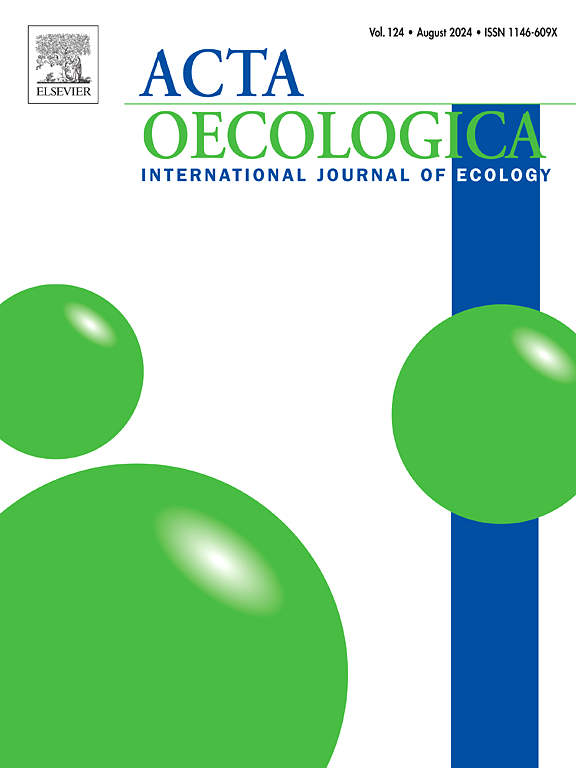双翅目和异翅目昆虫的运动能力:科学计量学综述
IF 1.3
4区 环境科学与生态学
Q3 ECOLOGY
Acta Oecologica-International Journal of Ecology
Pub Date : 2025-09-28
DOI:10.1016/j.actao.2025.104125
引用次数: 0
摘要
个体运动是物种长期生存能力的核心过程,因为它允许获得生存和繁殖的关键资源。移动与物种对景观变化的反应密切相关,更脆弱的物种通常受到的影响较小。在蜻蜓中,运动能力与身体形态密切相关,如翅膀和身体大小。一般来说,异翅目的物种比钩翅目的物种有更大的翅膀和身体,并且可能移动更远的距离。本文在文献综述的基础上,对成年大鼠的运动能力进行了综合研究。我们还评估了不同亚目(异翅目和夜翅目)之间的移动距离是否不同,以及这些移动是否与景观研究中使用的空间尺度(即测量景观指标的空间范围)一致。在1978 ~ 2025年间共发表了34篇文献,获得了32种昆虫的运动数据,其中异翅目17种,颧翅目15种。大多数研究都是在北半球开展的,自21世纪初以来有所增加。个体的运动通常是通过标记再捕获来评估的,但是遥测技术已经应用于大型物种。尽管文献表明无翅目的运动能力高于夜翅目,但我们没有观察到两个亚目之间的显著差异。结果表明,双翅目昆虫的中位距离为731.5 m(范围16 ~ 1790 m),异翅目昆虫的中位距离为224 m(范围89 ~ 1910 m)。景观研究较少,并且与Odonata的最大旅行能力相比,使用的一些空间尺度较小。基于这些结果,我们强调蜻蜓运动数据的稀缺性,特别是在热带地区。了解这些因素对于确定需求和确定保护策略至关重要,特别是对于对人为变化最敏感、受威胁和低移动能力的物种。本文章由计算机程序翻译,如有差异,请以英文原文为准。
Movement capacity in zygoptera and anisoptera (Odonata): a scientometric review
Individual movement is a central process for the long-term viability of species, as it allows access to key resources for survival and reproduction. Movement is closely associated with the response of species to landscape changes, with more vagile species typically being less affected. In Odonata, movement capacity is strongly related to body morphology, such as wing and body size. In general, species in the suborder Anisoptera have larger wings and bodies than species in the suborder Zygoptera and are likely to move over greater distances. In this paper, we synthesize knowledge about the movement capacity of adult Odonata based on a literature review. We also assess whether travel distances differ between the suborders (Anisoptera and Zygoptera), and whether these movements are consistent with the spatial scales used in landscape studies (i.e., the spatial extent at which landscape metrics are measured). We found 34 articles published between 1978 and 2025, from which we obtained movement data for 32 species (17 Anisoptera and 15 Zygoptera). Most studies were developed in the northern hemisphere, with an increase since the early 2000s. Individual movement is usually assessed by mark-recapture, but telemetry has been applied for large-bodied species. Despite the literature suggesting a higher movement capacity in Anisoptera than in Zygoptera, we observed no significant difference between the two suborders. Our results showed a median distance of 731.5 m (range: 16 to 1790 m) for Zygoptera and 224 m (range: 89 to 1910 m) for Anisoptera. Landscape studies were rare, and some spatial scales used were small compared to the maximum travel capacity of Odonata. Based on these results, we emphasize the scarcity of data on dragonfly movements, especially in tropical regions. Understanding these factors is essential to identify needs and define conservation strategies, especially for species most sensitive to anthropogenic changes, threatened and low movement capacity.
求助全文
通过发布文献求助,成功后即可免费获取论文全文。
去求助
来源期刊
CiteScore
3.60
自引率
0.00%
发文量
57
审稿时长
>0 weeks
期刊介绍:
Acta Oecologica is venue for the publication of original research articles in ecology. We encourage studies in all areas of ecology, including ecosystem ecology, community ecology, population ecology, conservation ecology and evolutionary ecology. There is no bias with respect to taxon, biome or geographic area. Both theoretical and empirical papers are welcome, but combinations are particularly sought. Priority is given to papers based on explicitly stated hypotheses. Acta Oecologica also accepts review papers.

 求助内容:
求助内容: 应助结果提醒方式:
应助结果提醒方式:


